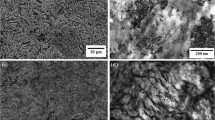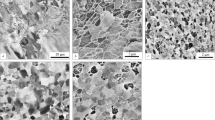Conclusions
-
1.
After the complete heat-treatment cycle the strength characteristics of low-carbon steel N26T increase substantially (∼15–20%) after cold treatment due to two additional operations — intermediate aging at a temperature below Af and a second cold treatment.
-
2.
The mechanical properties of the steel vary with the intermediate-aging temperature and improve as the temperature is raised from 500 to 625°.
-
3.
Intermediate aging at temperatures below Af induces destabilization of austenite and increases (∼12%) the amount of α phase formed during the subsequent cold treatment.
-
4.
The low strength characteristics after austenitizing at 720° are evidently due to the mutual effects of the two strengthening mechanisms — phase strain hardening and aging. The first mechanism is predominant at temperatures below 700°, and the second at higher temperatures.
Similar content being viewed by others
Literature cited
V. G. Gorbach, "Phase strain hardening during the γ→α→γ transformations," in: Metal Physics [in Russian], No. 27, Naukova Dumka, Kiev (1970), p. 3.
G. Krauss, Trans. Met. Soc. AIME,224, No. 6, 1212 (1962).
Additional information
Translated from Metallovedenie i Termicheskaya Obrabotka Metallov, No. 6, pp. 59–61, June, 1980.
Rights and permissions
About this article
Cite this article
Dianov, S.V., Radchenko, V.A., Rudman, V.A. et al. Effect of aging before repeated cold treatment on the mechanical properties of steel N26T. Met Sci Heat Treat 22, 454–457 (1980). https://doi.org/10.1007/BF00693656
Issue Date:
DOI: https://doi.org/10.1007/BF00693656




